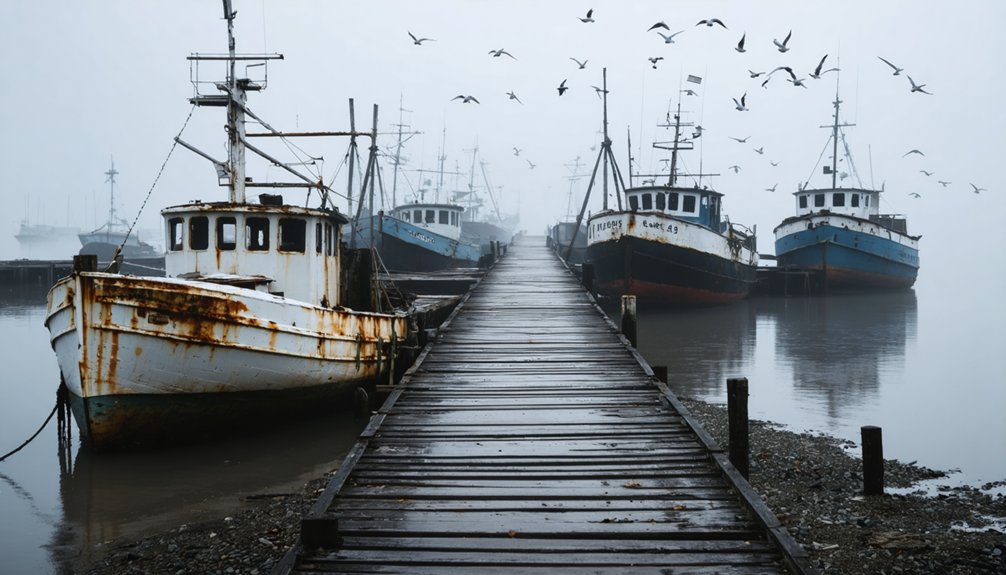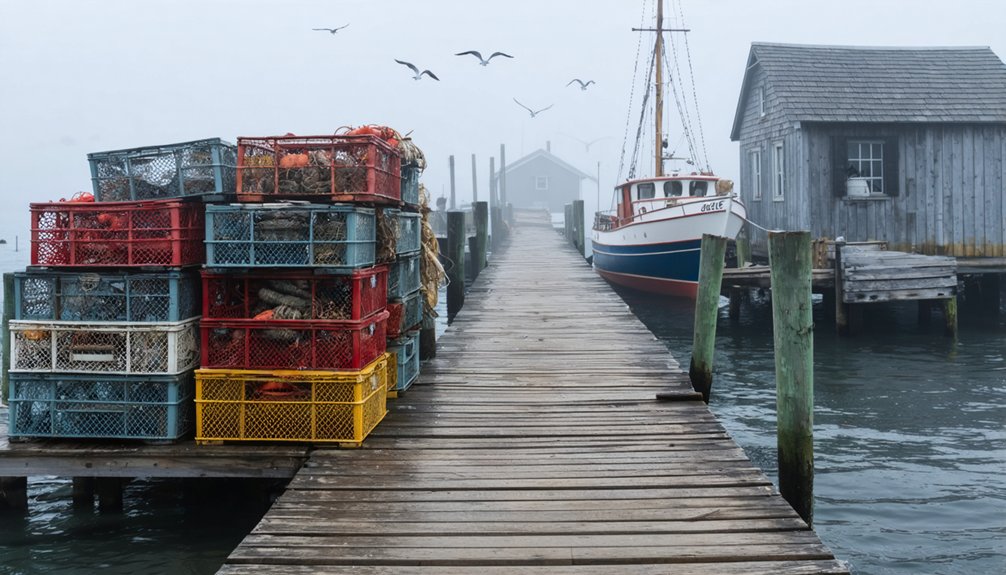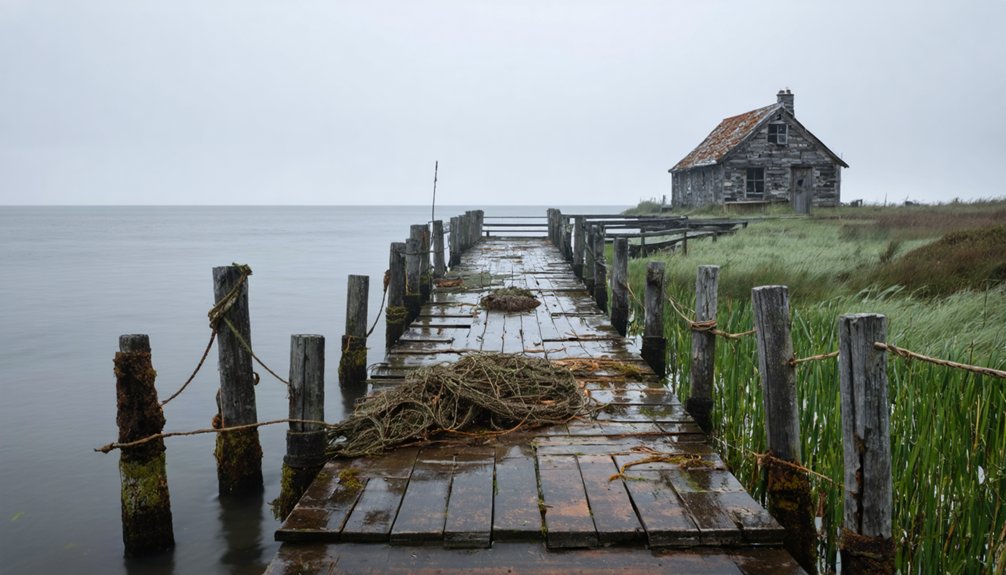America’s coastal waters once sheltered five notable ghost villages: Terminal Island, where Japanese-Americans revolutionized fishing before WWII evacuation; Stumpy Point, North Carolina’s 1939 seafood powerhouse; Terrapin Point, home to the “Terrapin King” before Prohibition’s deadly blow; Brown’s Island, where mullet seining supported generations until the 1940s; and Marines, a New River settlement captured in Farrell’s photographs before military requisition. These tide-worn settlements harbor tales of innovation, persecution, and resilience beneath their weathered remains.
Key Takeaways
- Terminal Island was forcibly evacuated in 1942 when Japanese-American fishing families were sent to internment camps during WWII.
- Stumpy Point in North Carolina has declined from its 1939 peak when it produced three million pounds of fish annually.
- Terrapin Point collapsed after 1919 due to Prohibition’s impact on terrapin stew demand and severe overharvesting.
- Brown’s Island’s mullet seining community faded after the 1940s despite earlier resilience against economic and environmental challenges.
- Marines, a New River fishing settlement, disappeared when the community was displaced by wartime requisition in 1941.
Terminal Island: A Japanese-American Fishing Legacy Lost to War
As the dawn of the twentieth century broke over California’s coastline, Terminal Island emerged as an unlikely maritime haven for Japanese immigrants who, by 1907, had established a thriving fishing settlement known as Fish Harbor.
The Pacific waters whispered opportunity to Japanese fishermen who transformed Terminal Island into their own flourishing maritime community
These seafarers revolutionized the industry with innovative fishing techniques – deploying scouting vessels to locate albacore tuna, utilizing live bait systems, and perfecting the art of spear fishing from boat walkways.
By the 1930s, their maritime prowess had anchored a population of 2,000 souls, with men working the decks while women manned the cannery lines. The island’s strategic location made it an integral part of Southern California’s fishing industry.
Your cultural identity would’ve been preserved in this “Furusato” (home sweet home), where a self-contained world of schools, shops, and annual celebrations flourished across five square blocks – until Pearl Harbor’s aftermath swept this vibrant community from the harbor’s edge. Following Executive Order 9066, Terminal Island residents became the first community to face forced evacuation and incarceration during World War II.
Stumpy Point: The Fading Heritage of North Carolina’s Coastal Fisheries
While Terminal Island’s Japanese fishing community succumbed to wartime prejudice, Stumpy Point evolved along North Carolina’s wave-lashed shoreline through different tides of fortune.
Founded by hardy souls who navigated life’s currents by establishing a network of canals—some excavated by enslaved hands—this settlement charted a course from agriculture to maritime enterprise by the late 19th century.
As farmland yielded diminishing harvests, residents cast their nets toward more promising waters.
You’ll find the echoes of economic shifts in Stumpy Point’s narrative: pound nets replaced cornfields, oysters became winter gold, and “buy boats” ferried the day’s catch to distant markets.
Local watermen fiercely defended their fishing traditions during the “Oyster War,” securing their maritime inheritance against well-armed interlopers.
Stumpy Point thrived in its prime, leading North Carolina in fish production in 1939 with an impressive three million pounds shipped annually.
Before modern transportation systems emerged, the community relied on shallow-drafted vessels that could effectively navigate the treacherous coastal shoals and sounds connecting barrier islands to mainland ports.
Today, as rising tides threaten this resilient harbor, Stumpy Point’s fishing heritage remains both anchor and compass.
Terrapin Point: Shifting Tides and Vanishing Maritime Culture
Beneath the salt-laden skies of Maryland’s Eastern Shore, Terrapin Point emerged in the late 19th century as the unlikely epicenter of a maritime gold rush—not for precious metals, but for diamondback terrapins.
The “Terrapin King,” Albert LaVallette Jr., steered Crisfield heritage toward prosperity by 1880, transforming local watermen into purveyors of luxury fare for urban markets.
You’d scarcely recognize the bustling docks of yesteryear. By 1919, the fishery began taking on water—Prohibition’s gale force winds capsized terrapin stew’s popularity when sherry became contraband.
The terrapin decline continued through the 1940s as overharvesting depleted the Bay’s once-abundant stock. The harvest numbers tell the devastating story, with catches plummeting from over 35,000 to fewer than 70 terrapins within a single decade.
What remains today are ghost piers and abandoned sloops—silent sentinels marking the ebb and flow of maritime fortunes that once defined this vanishing corner of Chesapeake culture.
Brown’s Island: Remnants of a Once-Thriving Commercial Fishing Hub
During the halcyon days of the early 20th century, Brown’s Island emerged as a maritime sentinel along North Carolina’s windswept coastline, despite its humble origins as two separate landmasses in 1789.
Like a nautical phoenix, Brown’s Island rose from dual origins to stand watch over Carolina’s tempestuous shores.
You’ll find echoes of traditional fishing techniques in the island’s history, where mullet seining sustained families from the early 1900s through the 1940s.
The 1938 documentation captures a community’s resilience against changing tides – both literal and economic. This resilience mirrors the history of Ohio’s Browns Island, which was primarily used for farming and residence until the 1900s when industrial interests transformed its landscape.
The island has a rich archaeological significance with artifacts dating back to the Archaic Period and evidence of Native American presence.
These seafarers weathered storms literal and figurative, with women, children, and people of color forming the backbone of operations often overlooked in historical ledgers.
Marines: A Ghost Village Among North Carolina’s Lost Fishing Communities
Unlike its more documented counterparts along the Atlantic seaboard, Marines emerged as a quintessential fishing settlement on North Carolina’s New River, where its maritime heritage flourished from the 1930s until its abrupt demise in 1941.
Before wartime requisition ran this village aground, you’d have found a vibrant maritime community casting nets and steering deadrise skiffs beneath Carolina skies. Similar to the communities where Charles A. Farrell documented everyday life, Marines represented the cultural heritage and labor traditions of coastal North Carolina. The village once boasted a Delco-Light system that provided early electricity to residents before its destruction.
The Marines legacy lives on through:
- Charles Farrell’s photographic chronicles, capturing the weathered faces of those who rode New River’s tides
- Oral histories from displaced mariners who weathered the storm of forced relocation
- Two churches and Joe Wilson’s dance hall that once anchored this seafaring society
- Community resilience demonstrated as families adapted to life after their anchorage was commandeered for Camp Lejeune’s establishment
Frequently Asked Questions
Can Abandoned Fishing Villages Be Legally Explored by Visitors?
90% of these village sites are legally explorable! You can navigate public coastal settlements under legal regulations that prioritize visitor safety while ensuring your freedom to chart maritime history’s forgotten harbors.
What Wildlife Now Inhabits These Deserted Coastal Communities?
You’ll sight raccoons, feral pets, and deer aboard these ghost ports. Wildlife adaptation transforms derelict docks into havens where gulls, alligators, and marine fauna navigate the ecological impact of humanity’s ebbing tide.
Are There Preservation Efforts to Document These Villages Before Disappearing?
Yes, you’ll find heritage conservation groups dropping anchor at these sites. Historical documentation efforts chart these villages’ coordinates precisely, preserving maritime legacies before the tide of time washes their stories away forever.
How Have Local Economies Adapted After Fishing Village Collapses?
You’ll see harbors transformed through economic diversification as communities drop anchor in tourism development, converting fishing wharves to tourist docks, and charting new courses through hospitality since the late 20th century tide shifts.
Do Former Residents Hold Reunions or Commemoration Events?
You’ll find reunion nostalgia anchors former seafarers annually at Terminal Island and Aleutian communities, while St. Malo’s descendants gather during heritage festivals, maintaining community ties despite their villages slipping beneath time’s tide.
References
- https://www.islands.com/1696596/florida-gulf-coast-hides-little-known-serene-cortez-historic-fishing-village-cortez-seafood/
- https://repository.library.noaa.gov/view/noaa/19459/noaa_19459_DS1.pdf
- https://coastalreview.org/2022/01/lost-photographs-remembering-ncs-fishing-communities/
- https://repository.library.noaa.gov/view/noaa/19456/noaa_19456_DS1.pdf
- https://www.startribune.com/tradition-lives-on-in-fishing-village/130372683
- https://www.frdc.com.au/sites/default/files/products/2002-223-DLD.pdf
- https://www.messynessychic.com/2021/11/23/the-japanese-fishing-village-that-vanished-from-los-angeles/
- https://herlifeadventures.com/8-historic-us-coastal-towns-where-fishing-culture-still-thrives/
- https://www.youtube.com/watch?v=1a__qFVnlMg
- https://priceschool.usc.edu/news/terminal-island-history-japanese-los-angeles/



